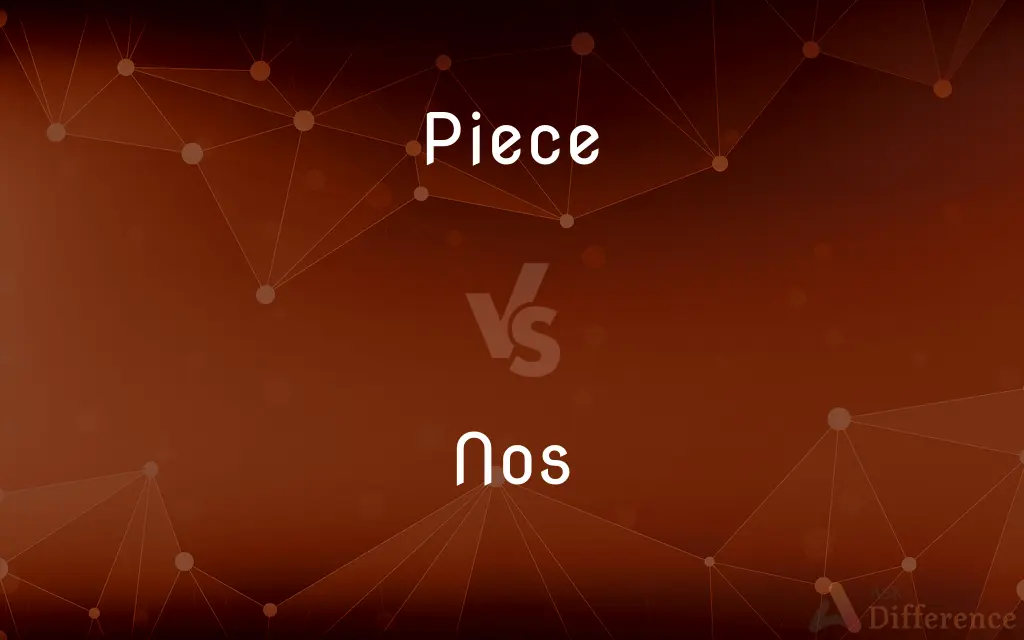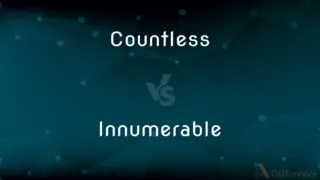Piece vs. Nos — What's the Difference?
By Fiza Rafique & Urooj Arif — Updated on March 1, 2024
"Piece" refers to a single item or part of something, while "Nos" is an abbreviation for "numbers," often used to specify quantity or inventory items.

Difference Between Piece and Nos
Table of Contents
ADVERTISEMENT
Key Differences
The term "piece" is used to describe a single item or part of a larger whole, highlighting its individuality or its role as a component. It can apply to various contexts, from art (a piece of artwork) to manufacturing (a piece of machinery). The emphasis is on the singularity or integrity of the item in question. "Nos," short for "numbers," is an abbreviation commonly seen in inventories, lists, or documentation to denote quantity. It is often used to specify how many units of a particular item are being referred to or accounted for. For instance, in a list of materials for a project, "5 nos. of screws" would indicate that five individual screws are required.
"Piece" focuses on the individual nature or identity of an item, "Nos" emphasizes the count or quantity of items, often in a more impersonal or administrative context. "Piece" can invoke a sense of quality or uniqueness, whereas "Nos" is purely quantitative, relating to numbers or amounts.
The use of "piece" is versatile, applicable in everyday language as well as specific industries, including fashion, art, and manufacturing. On the other hand, "Nos" is typically used in contexts where precision in quantity is essential, such as in inventory control, ordering supplies, or specifying parts in technical and commercial documents.
Understanding the distinction is important for clear communication, especially in professional, technical, or commercial settings. Using "piece" or "Nos" appropriately can convey accurate information about the individuality or quantity of items, respectively.
Comparison Chart
Definition
A single item or part of a larger whole.
Abbreviation for "numbers," indicating quantity.
ADVERTISEMENT
Context
General use, emphasizing individuality or integrity.
Technical, inventory, or administrative contexts, emphasizing quantity.
Implication
Focuses on the singularity or uniqueness of an item.
Focuses on the count or amount of items.
Usage
Versatile across various contexts.
Primarily used in lists, documentation, or inventories.
Example
"A piece of artwork"
"5 nos. of screws"
Compare with Definitions
Piece
A single element of a larger whole.
He bought a piece of land.
Nos
Specifies quantity in documentation.
Order included 10 nos. of notebooks.
Piece
A portion or section of something.
Please cut the cake into small pieces.
Nos
Used in inventories for counting items.
The warehouse stocks 300 nos. of chairs.
Piece
Refers to an item in a collection.
He added another rare piece to his collection.
Nos
Helps in specifying parts or units.
Required: 4 nos. of batteries.
Piece
A work of art or creativity.
The museum displayed a new piece by the artist.
Nos
Indicates the count in technical specifications.
The design includes 6 nos. of LED lights.
Piece
An individual item, distinct in nature.
She wore a unique piece of jewelry.
Nos
Facilitates precise ordering or listing.
Please supply 2 nos. of the specified valves.
Piece
A portion of an object or of material, produced by cutting, tearing, or breaking the whole
A piece of cheese
The dish lay in pieces on the floor
Nos
Alternative form of nos.}} {{abbreviation of
Piece
A written, musical, or artistic creation
A haunting piece of music
Piece
An instance or example
A crucial piece of evidence
Piece
A thing considered as a unit or an element of a larger thing, quantity, or class; a portion
A piece of string.
Piece
A portion or part that has been separated from a whole
A piece of pie.
Piece
An object that is one member of a group or class
A piece of furniture.
Piece
A definite portion or quantity, as of goods or work; as, a piece of broadcloth; a piece of wall paper.
Piece
Any one thing conceived of as apart from other things of the same kind; an individual article; a distinct single effort of a series; a definite performance
Piece
Make by putting pieces together;
She pieced a quilt
He tacked together some verses
Piece
Join during spinning;
Piece the broken pieces of thread, slivers, and rovings
Piece
Eat intermittently; take small bites of;
He pieced at the sandwich all morning
She never eats a full meal--she just nibbles
Piece
Repair by adding pieces;
She pieced the china cup
Common Curiosities
What does "piece" imply in usage?
"Piece" implies a focus on the individual nature, uniqueness, or integrity of an item.
Where is "Nos" commonly used?
"Nos" is commonly used in technical, inventory, or administrative contexts to specify quantity.
Can "piece" and "Nos" be used interchangeably?
No, because "piece" emphasizes the individuality of an item, while "Nos" emphasizes quantity.
Can a "piece" refer to a work of art?
Yes, "piece" can refer to a work of art, emphasizing its status as a singular creation.
Is "piece" specific to certain industries?
While "piece" is versatile and used across various industries, its implication of uniqueness or individuality may be particularly significant in art, fashion, and manufacturing.
How do "Nos" facilitate precise ordering?
"Nos" allows for specific quantification, ensuring accurate supply and inventory control.
Is the use of "Nos" limited to physical items?
Primarily, yes, "Nos" is used for counting physical items, though it can also apply to abstract quantities in some documentation.
How does the context of usage affect the choice between "piece" and "Nos"?
The choice is influenced by whether the focus is on the uniqueness and integrity of an item ("piece") or on the quantity of items ("Nos").
How does "Nos" assist in inventory management?
"Nos" helps in precisely counting and documenting the quantity of items in inventory.
Why is understanding the difference between "piece" and "Nos" important?
Understanding the difference ensures clear communication, especially in contexts where precision about quantity or the nature of items is crucial.
Share Your Discovery

Previous Comparison
Countless vs. Innumerable
Next Comparison
Lambrusco vs. ChiantiAuthor Spotlight
Written by
Fiza RafiqueFiza Rafique is a skilled content writer at AskDifference.com, where she meticulously refines and enhances written pieces. Drawing from her vast editorial expertise, Fiza ensures clarity, accuracy, and precision in every article. Passionate about language, she continually seeks to elevate the quality of content for readers worldwide.
Co-written by
Urooj ArifUrooj is a skilled content writer at Ask Difference, known for her exceptional ability to simplify complex topics into engaging and informative content. With a passion for research and a flair for clear, concise writing, she consistently delivers articles that resonate with our diverse audience.
















































